Kitchen countertops do a lot of heavy lifting and set the tone for your whole kitchen. Picking the right material isn’t just about looks—it’s a big decision that affects durability, upkeep, and your wallet.
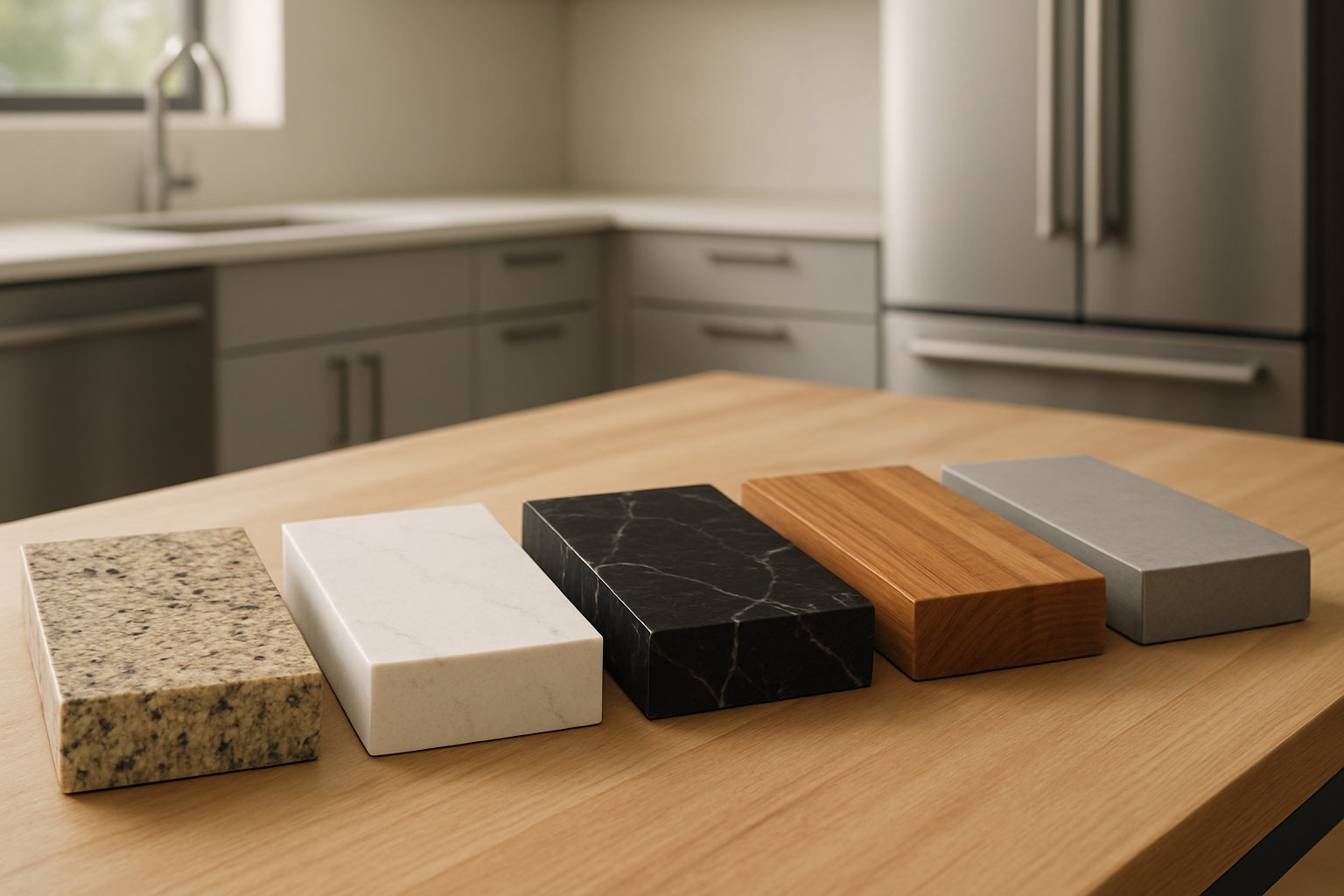
The best long-lasting and stylish kitchen countertop materials include quartz, granite, and marble, each offering unique benefits in terms of durability, appearance, and maintenance requirements. These stones—whether natural or engineered—can last for decades if you treat them right. Their costs, care needs, and how well they handle heat, scratches, or stains can really differ, though.
Knowing the ins and outs of each material helps you pick what fits your habits, style, and future plans. From budget laminates to high-end stone, every option brings something different to your kitchen’s function and feel.
Key Takeaways
- Quartz, granite, and marble stand out for mixing durability with good looks in kitchen countertops
- Each material comes with its own quirks—maintenance, resistance, and long-term costs all vary
- Finding the right fit means balancing budget, lifestyle, and what you want your kitchen to say about you
How Countertop Materials Impact Longevity and Style
The countertop material you choose really sets the stage for how long your kitchen will look sharp—and how much effort you’ll spend keeping it that way. Some materials just handle the daily grind better than others.
Need a Home Fix – Emergency or Routine?
From leaks and no-heat nights to simple tune-ups, our 24/7 hotline connects you with trusted local pros in minutes.
Why Material Choice Matters
Countertop materials aren’t all created equal. Some last for ages, while others start showing their age after just a few years.
Quartz countertops shrug off stains and never need sealing. You can keep them looking good for 15-20 years with just basic cleaning.
Granite is tough as nails if you keep up with sealing. It laughs off hot pans and knife scratches, but you’ll need to reseal it every few years to keep stains at bay.
Laminate is easy on the wallet but doesn’t go the distance—expect 10-15 years, tops. It scratches and peels if you’re rough on it.
Generally, the more you pay upfront, the longer your countertop will last. Granite and quartz cost more per square foot than tile, but they stick around a lot longer.
Maintenance is a biggie, too. Natural stone needs sealing, but quartz is pretty low-maintenance.
Influence on Kitchen Design and Remodeling
Countertops aren’t just practical—they’re front and center in your kitchen’s look. They pull together cabinets, floors, and backsplashes in ways you might not notice until you see the wrong combo.
Natural stone like marble and granite brings wild, one-of-a-kind patterns. No two slabs are the same, which is pretty cool if you ask me.
Solid-surface materials give you more control over patterns and colors. They’re a safe bet for modern, minimalist spaces.
Light countertops can open up a small kitchen. Dark ones? They bring drama, especially against white cabinets.
The countertop you pick even impacts your other choices. Bold granite patterns work best with simple cabinets, while plain quartz lets you get wild with your backsplash.
Thickness changes the vibe, too. Thin slabs feel modern, thick ones look classic and sturdy.
Factors Affecting Durability and Aesthetics
What makes a countertop last? It’s not just the stone—it’s how it handles heat, scratches, stains, and even sunlight.
Heat resistance is all over the map. Granite and concrete can take the heat, but quartz and laminate can get ruined by a hot pan in seconds.
Scratch resistance depends on hardness. Granite wins here, while marble and wood can get scuffed up fast.
Stain protection comes down to how porous the material is. Quartz doesn’t let stains in, but granite needs sealing to keep them out.
Water resistance matters if you cook a lot. Porous countertops can get gross if water seeps in and mold moves in.
UV stability is a thing near windows. Some countertops fade if they soak up too much sun.
Chip resistance is worth thinking about, especially near sinks and edges—those spots take a beating during remodels.
Top Long Lasting and Stylish Kitchen Countertop Materials
If you want a countertop that will last and look good, stone is tough to beat. Quartz is all about consistency and easy care, granite brings natural beauty and heat resistance, while marble is your go-to for luxury—though it’s a bit more high-maintenance.
Quartz Countertops
Quartz countertops are made with about 90% crushed quartz, mixed with resins and minerals. This engineered stone gives you a non-porous surface that shrugs off stains, mold, and bacteria—no sealing needed, ever.
You get a ton of color and pattern options. Want solid white? Marble look? Something wild? There’s a quartz for that. What you see is what you get—no weird surprises when it shows up.
Maintenance is a breeze—just wipe with soap and water. Spills don’t soak in, so cleanup is quick.
But, watch out for heat. Hot pots can scorch the resin and leave marks. Some quartz can fade if you put it in direct sun for years.
| Pros | Cons |
|---|---|
| No sealing required | Heat sensitive |
| Stain resistant | Can scratch |
| Consistent patterns | Fades in sunlight |
Granite Countertops
Granite gives you a super durable, natural stone that can last for decades if you treat it right. Every slab is unique, thanks to the minerals swirling around for millions of years.
It’s a champ with heat. Set a hot pot right on it and it won’t blink. Plus, it resists knife scratches better than almost anything else.
You’ll need to seal granite every few years. If you don’t, stains and bacteria can sneak in.
Installation isn’t a DIY job. Granite is heavy—like, really heavy—so you’ll want pros to handle it.
Granite comes in all sorts of colors and patterns. Whether you want classic black, snowy white, or something in between, you’ll find a slab that fits your style.
Marble Countertops
Marble is the gold standard for luxury kitchens. Its veining makes every slab a piece of art.
Carrara, Calacatta, and Statuario are the big names in marble. Each one has its own vibe, from soft gray veins to bold gold streaks.
Marble can handle heat—great for baking and pastry work. The surface stays cool, which is handy if you’re into bread or dough.
But, it needs more TLC than granite or quartz. You’ll want to seal it every year to avoid stains from things like wine or lemon juice.
It scratches and etches more easily than granite. If you’re rough with knives or spill something acidic, you might end up with a permanent reminder.
That said, marble countertops can bump up your home’s value. Their timeless luxury makes them a favorite in high-end kitchens.
Other Popular Countertop Materials for Kitchens
Wood countertops usually run $50 to $150 per square foot, but you’ll need to keep up with oiling. Concrete is tough and heat-resistant, though it needs professional sealing every couple of years. Laminate is the cheapest—$20 to $80 per square foot—and you can install it yourself if you’re handy.
Wood Countertops
Wood countertops add warmth and a homey vibe. You’ll see maple, oak, teak, and ash used most often.
With the right care, wood can stick around for decades. It’s surprisingly sturdy for daily kitchen use.
You do have to keep up with maintenance. For the first year, oil it every month to prevent drying out or cracking.
Maintenance Schedule:
- Monthly oiling for first 12 months
- Sanding and resealing every 2-3 years
- Regular cleaning with mild soap only
Wood soaks up moisture and stains if you skip the sealing. Bacteria can set up shop in the pores if you’re not careful.
Hot pans and knives are a no-go on wood countertops. Always use a cutting board and trivet if you want your counters to last.
Concrete Countertops
Concrete brings an industrial edge to modern kitchens. Contractors pour these in place, so you get a perfect fit every time.
It resists scratches and heat better than most materials. You can put a hot pan right on it—no worries up to 1,200°F.
You can tint concrete almost any color, and pick from all sorts of textures. Want something bold? Go for it.
Concrete Benefits:
- Scratch resistant surface
- Handles heat like a champ
- Custom colors and textures
- Durable, if you keep up with it
But, it’s porous. You need to seal it every year or two, or you’ll get stains and maybe even bacteria.
Sometimes, homes settle and cracks show up in the concrete. Over-tightening fixtures can cause cracks, too—it’s a bit fussy that way.
Expect to pay $50 to $150 per square foot, labor included.
Butcher Block Countertops
Butcher block countertops use thick wood planks glued together for strength. Maple is still the top pick for butcher block construction.
The thick construction stands up to heavy cutting and chopping. Professional kitchens love butcher block for prep areas because it’s just that tough.
Bamboo gives you an eco-friendly twist on the classic hardwood look. Since bamboo grows so quickly, it offers similar strength but with a lighter environmental footprint.
Regular maintenance keeps butcher block looking fresh. Oil treatments every few weeks prevent drying and cracking, but honestly, it’s not hard to forget sometimes.
Care Requirements:
- Oil treatment every 3-4 weeks
- Sand out deep scratches as needed
- Clean with mild soap and water only
- Dry thoroughly after each use
Food safety takes extra work with butcher block. Raw meat juices can soak in and cause contamination if you aren’t careful.
The wood ages naturally, picking up character as it goes. Light wood darkens and develops a patina with regular use, which looks pretty cool if you ask me.
Laminate Countertops
Laminate countertops are the most affordable choice for kitchen makeovers. Installation usually costs $20 to $80 per square foot, materials and labor included.
Modern laminate copies the look of stone, wood, or even metal. High-def printing creates textures and patterns that can fool just about anyone at first glance.
The nonporous surface shrugs off mold, mildew, and bacteria. Cleaning is as easy as soap and water—no fancy products needed.
Laminate Advantages:
- Lowest material cost
- Easy DIY installation
- Stain resistant surface
- Wide variety of colors and patterns
Heat is laminate’s enemy. Set a hot pan down, and you’ll probably get a white mark or a burn you can’t fix.
Sharp knives cut through the thin surface fast. Deep scratches will show the particleboard core underneath, which isn’t a great look.
Most laminate countertops last about 10-15 years with normal use. After a while, you’ll probably notice the edges peeling if moisture gets in.
When laminate countertops wear out, replacing them is pretty simple and doesn’t break the bank.
Solid Surface and Alternative Countertop Materials
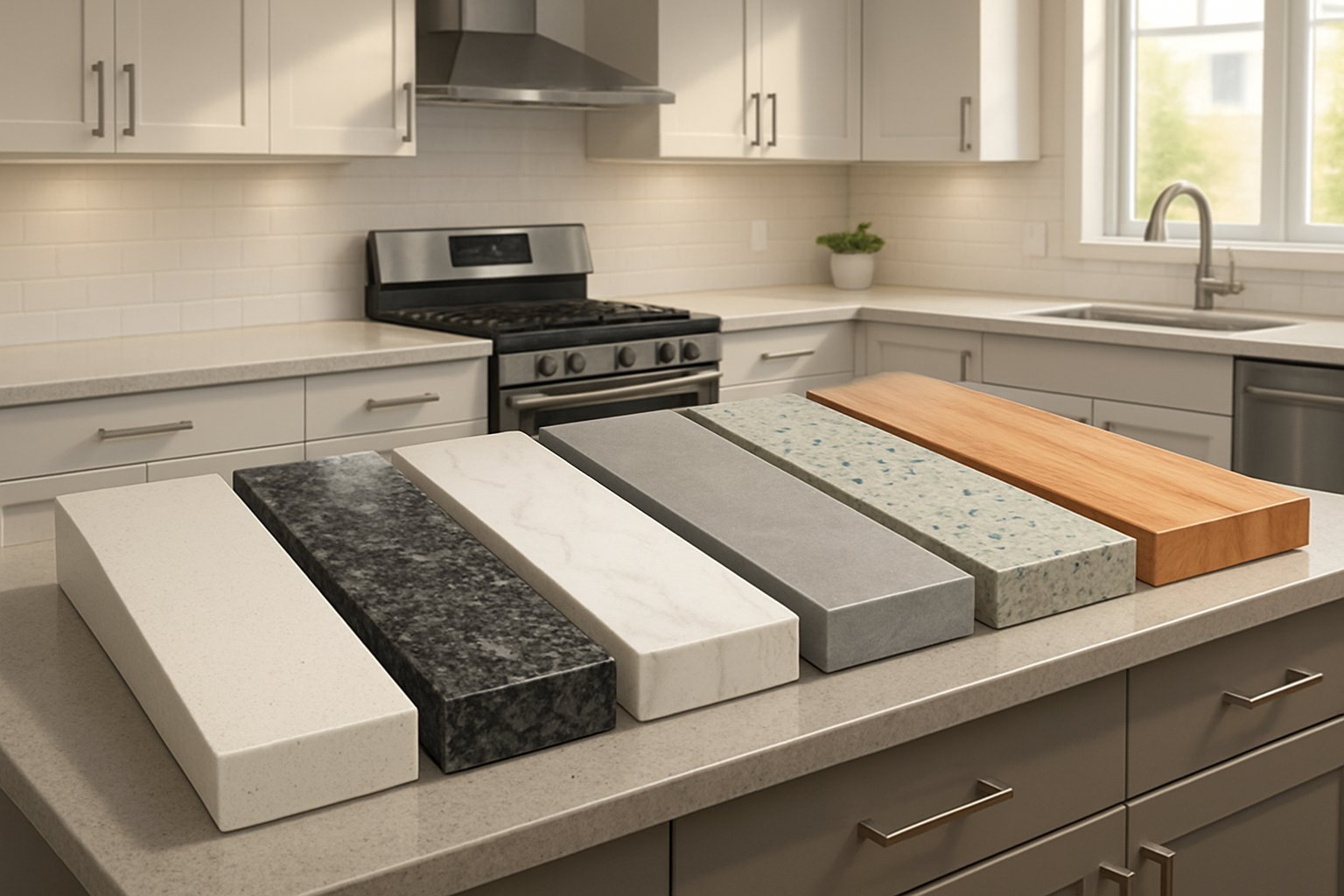
Solid surface countertops sit somewhere between natural stone and laminate. Lately, homeowners are looking for unique countertop materials that break away from the usual choices.
Solid Surface Countertops
Solid surface countertops mix resins, pigments, and acrylic particles. They heat and mold the blend into counters that look seamless.
These counters resist scratches and stains better than some natural stones. The surface stays smooth and easy to clean. If you get a minor scratch, you can sand and polish it out.
Key Benefits:
- Wide range of colors and patterns
- Non-porous surface resists bacteria
- Seamless installation possible
- Repairable surface
Price Range: $40-80 per square foot installed
Durability: Medium to high
Maintenance: Low daily care, periodic polishing needed
Solid surface works well for busy kitchens. It takes daily use without showing wear right away. The color stays consistent throughout the material, which is handy if you need to sand it down.
Popular brands like Corian, Formica, and Hi-Macs offer tons of color options. Some even mimic natural stone pretty convincingly.
Emerging and Specialty Materials
Some unique kitchen countertop materials serve specific needs. They give you alternatives to the usual stone or solid surface picks.
Stainless Steel fits modern kitchens with its clean, almost industrial vibe. Restaurants use it for a reason—it resists heat and bacteria. It costs $70-100 per square foot but can last for decades if you don’t mind the occasional scratch.
Concrete lets you pick custom colors and textures. Installation takes skill to avoid cracks. Prices run $50-100 per square foot, depending on how fancy you get with the finish.
Recycled Glass mixes old bottles with resins for a wild, colorful look. The surface handles stains and heat well. Costs usually fall between $60-90 per square foot installed.
Copper changes color over time, developing a patina that’s either love-it-or-hate-it. Its antimicrobial powers are a bonus for food prep, but you’ll need to keep up with maintenance if you want to control how it ages.
Each specialty material fits different budgets and design goals. Some are more practical than others, but hey, that’s kitchen design for you.
Comparing Performance: Durability, Maintenance, and Cost
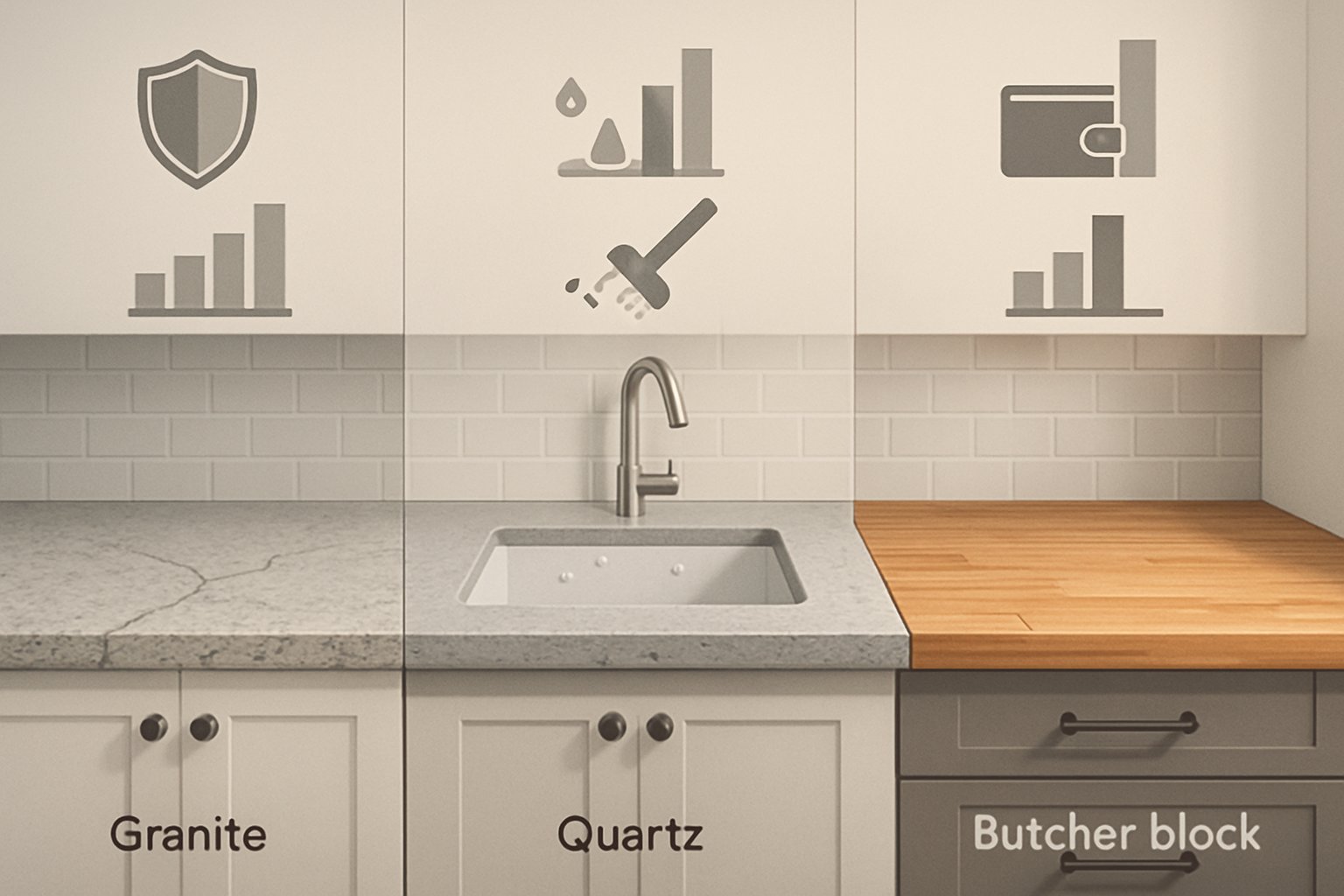
Countertop materials all have their quirks. Quartz leads for low maintenance, while natural stones need more care. Budgets stretch from affordable laminate to premium granite and marble.
Scratch, Heat, and Stain Resistance
Quartz stands out for scratch resistance. It shrugs off most daily wear from knives and tools.
Granite resists scratches well but can chip at the edges. It handles heat, so you can set hot pans down without worry.
Marble scratches and stains easily. Acidic stuff like lemon juice can leave permanent marks, which is kind of a bummer.
Butcher block shows scratches and dents fast. Some folks love that “lived-in” look, but deep cuts can trap bacteria.
Concrete resists scratches if you seal it. Skip the sealant, and it’ll soak up stains in no time.
Heat resistance jumps all over the place. Granite and concrete handle high temps best. Quartz can discolor if it gets too hot. Marble is okay with moderate heat, but don’t push your luck with scorching pans.
Maintenance and Care Requirements
Quartz countertops just need soap and water. No sealing—ever. Can’t get much easier than that.
Granite needs sealing every 1-2 years to keep stains away. Mild soap does the trick for daily cleaning.
Marble requires you to wipe up spills right away and seal it monthly. Special marble cleaners help prevent etching.
Wood countertops need oiling every month to keep from cracking or soaking up water. Sanding fixes deep scratches or stains.
Concrete needs sealing every few years. Use pH-neutral cleaners to keep the surface looking good.
Natural stone usually takes more attention than engineered surfaces. How often you maintain them depends on how you use your kitchen.
Budget and Value Considerations
Laminate runs $10-40 per square foot installed. It’s great for tight budgets but doesn’t last as long as other options.
Butcher block costs $30-70 per square foot. It’s mid-range, feels warm, but you’ll pay more over time for upkeep.
Quartz usually costs $60-100 per square foot installed. You pay more upfront but save on maintenance.
Granite varies from $40-100 per square foot, depending on the slab quality. Installation can get pricey if your layout is complicated.
Marble sits at $60-120 per square foot. Add in maintenance, and the long-term costs add up.
Quartz and granite usually give you the best return on investment if you plan to sell your home down the line.
Choosing the Right Kitchen Countertop Material for Your Home
Your countertop choice shapes daily life, home value, and how much you enjoy your kitchen. The right material balances your family’s habits, style, and how much maintenance you’re willing to handle.
Evaluating Lifestyle and Kitchen Usage
Heavy cooking families need tougher materials than casual cooks. If you have multiple chefs in the kitchen, scratch-resistant granite or quartzite is a smart call.
Heat resistance matters most for bakers. Granite and marble can handle hot pans, but quartz and laminate need a trivet or hot pad.
Think about your maintenance preferences:
- Low maintenance: Quartz—no sealing required
- Medium maintenance: Granite—seal every 3-5 years
- High maintenance: Marble—annual sealing and extra care
Family size can tip the scales. Large families do better with tough stuff like granite or concrete. Smaller households can get away with softer options like soapstone.
Budget makes a big difference. Laminate starts at $20-80 per square foot, while high-end granite can hit $100-200 per square foot.
Coordinating With Kitchen Style and Elements
Modern kitchens look sharp with quartz or stainless steel. These materials pair well with sleek cabinets and appliances.
Traditional designs shine with natural stone—marble or granite. The veining adds that timeless character.
Color coordination is trickier than it sounds:
- Light countertops brighten up dark cabinets
- Dark surfaces pop against white cabinets
- Neutral tones play nice with any color scheme
Cabinet hardware should work with your countertop. Brushed metals look good with stone, while chrome fits modern quartz.
Edge profiles matter, too. Simple edges fit modern spaces. Decorative edges suit traditional kitchens better.
Remodeling Tips for Long-Term Satisfaction
Plan ahead when picking materials. Think about how your needs might shift over the next decade or so.
Professional installation is worth it, especially for heavy stuff like granite. Experienced installers prevent cracks and other headaches.
Order samples before you commit. Materials can look totally different under your kitchen lights.
Order early if you’re remodeling. Custom fabrication takes a few weeks, and delays can drag out your project.
Measure twice—seriously. Bad measurements mean delays and extra costs.
Consider resale value if you might move someday. Granite and quartz appeal to most buyers, but trendy picks like concrete might not be everyone’s cup of tea.
Frequently Asked Questions
Picking a kitchen countertop means sorting through a lot of details—durability, maintenance, material types, and more. Heat resistance jumps from quartz at 300°F to granite at 1,200°F. Eco-friendly options now include recycled glass and bamboo, which is pretty neat if you care about the planet.
What are the top-rated materials for durability in kitchen countertops?
Quartz sits at the top for durability, thanks to its engineered composition of 90% crushed stone and 10% resin. This combo forms a non-porous surface that shrugs off scratches, stains, and chips better than most natural stones.
Quartzite’s a close second as a natural stone choice. It’s seriously hard, resists scratches, and holds up to heat—up to 1,200°F, if you’re curious.
Granite lands in third place for durability. It fights off scratches and heat but needs a sealing touch-up every year or two.
Stainless steel brings industrial-level toughness, perfect for heavy-use kitchens. It resists heat, stains, and bacteria, though it does need some care to keep looking sharp.
How do maintenance requirements vary between different countertop materials?
Quartz keeps things easy—just wipe it down with mild soap and water. You’ll never need to seal it, which is honestly a relief.
Natural stones like granite and marble need regular sealing every year or two. If you spill something acidic, you’d better clean it up quick to avoid stains.
Butcher block asks for the most attention. You’ve got to oil it every month with food-grade mineral oil, and while you can sand out deep scratches, water damage can be a real headache.
Laminate’s low-maintenance, just basic cleaning needed. But it shows scratches and burns easily, and if you damage a section, you usually have to replace the whole thing.
Concrete needs a seal once a year to fight off stains and cracks. Regular waxing helps it stay good-looking and keeps moisture at bay.
Which countertop materials offer the best balance of longevity and aesthetic appeal?
Quartz nails the balance—expect 20-25 years of use with consistent color and pattern. It looks like stone but skips the sealing and staining worries.
Granite lasts 15-20 years and brings unique natural patterns to the table. Every slab’s different, with its own veining and colors.
Marble’s gorgeous, no doubt, but it needs careful maintenance to last. In a busy kitchen, you might see wear in 10-15 years if you’re not careful.
Butcher block feels warm and practical, usually lasting 10-15 years. Keep up with maintenance and you’ll keep it solid and attractive.
What are the benefits of engineered stone versus natural stone countertops?
Engineered stone gives you consistent color and pattern from slab to slab. The manufacturing process skips natural flaws like fissures and weak spots.
It’s non-porous, so it resists bacteria and stains without any sealing. That means less maintenance and no chance you’ll forget to reseal.
Natural stone, on the other hand, has one-of-a-kind patterns and colors. Each slab’s a little piece of earth’s history—pretty cool, honestly.
If you’re worried about heat, natural stone wins, especially granite and quartzite. These can take direct hits from hot pans up to 1,200°F, while quartz tops out at 300°F.
Costs bounce around depending on the material and grade. Basic quartz can be cheaper than fancy granite, but rare natural stones can get pricey.
Can you compare the heat resistance of various kitchen countertop materials?
Granite and quartzite can handle up to 1,200°F, so go ahead—put that hot pan down. These stones formed under intense heat and pressure, so they’re used to it.
Concrete’s not far behind, managing up to 1,000°F if you’ve sealed it right. Its thermal mass actually helps spread heat around the surface.
Stainless steel takes heat well, though it might discolor or warp if you really push it. Thicker, commercial-grade steel does better than the thin stuff in most homes.
Quartz is a bit sensitive, with a 300°F limit because of the resin binders. Put a hot pan on it and you risk a permanent mark or even a crack.
Laminate and butcher block? Not so heat-friendly. Anything over 150°F can burn, warp, or ruin them, and you’ll probably need to replace damaged spots.
What are the latest trends in eco-friendly kitchen countertop materials?
Recycled glass countertops use about 85% post-consumer glass waste. Instead of sending glass to landfills, manufacturers turn it into durable, speckled surfaces that look pretty cool and one-of-a-kind.
Paper-based composites mix recycled paper with cashew shell resin. With these, you get countertops made from renewable stuff, and when they’re done, they break down way more easily than anything made from petroleum.
Bamboo countertops come from fast-growing bamboo grass. The harvest cycle is just 3 to 5 years—so much quicker than waiting for hardwood trees to mature, which can take decades.
Reclaimed wood surfaces give new life to old lumber salvaged from demolished buildings. There’s a bit of history in every slab, and using them means we don’t have to chop down more trees.
Bio-based resins swap out petroleum products for plant-based binders in engineered stone. These resins shrink the carbon footprint but still keep the countertop tough and reliable.
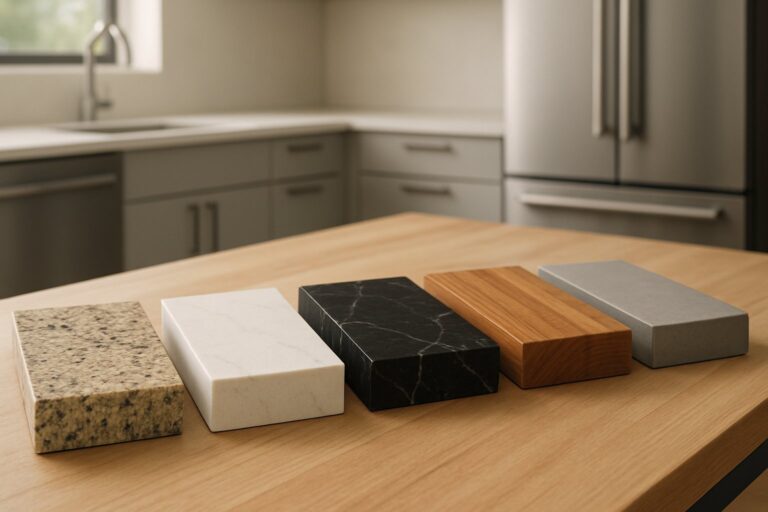



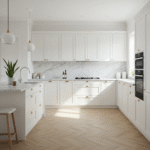


Leave a Reply